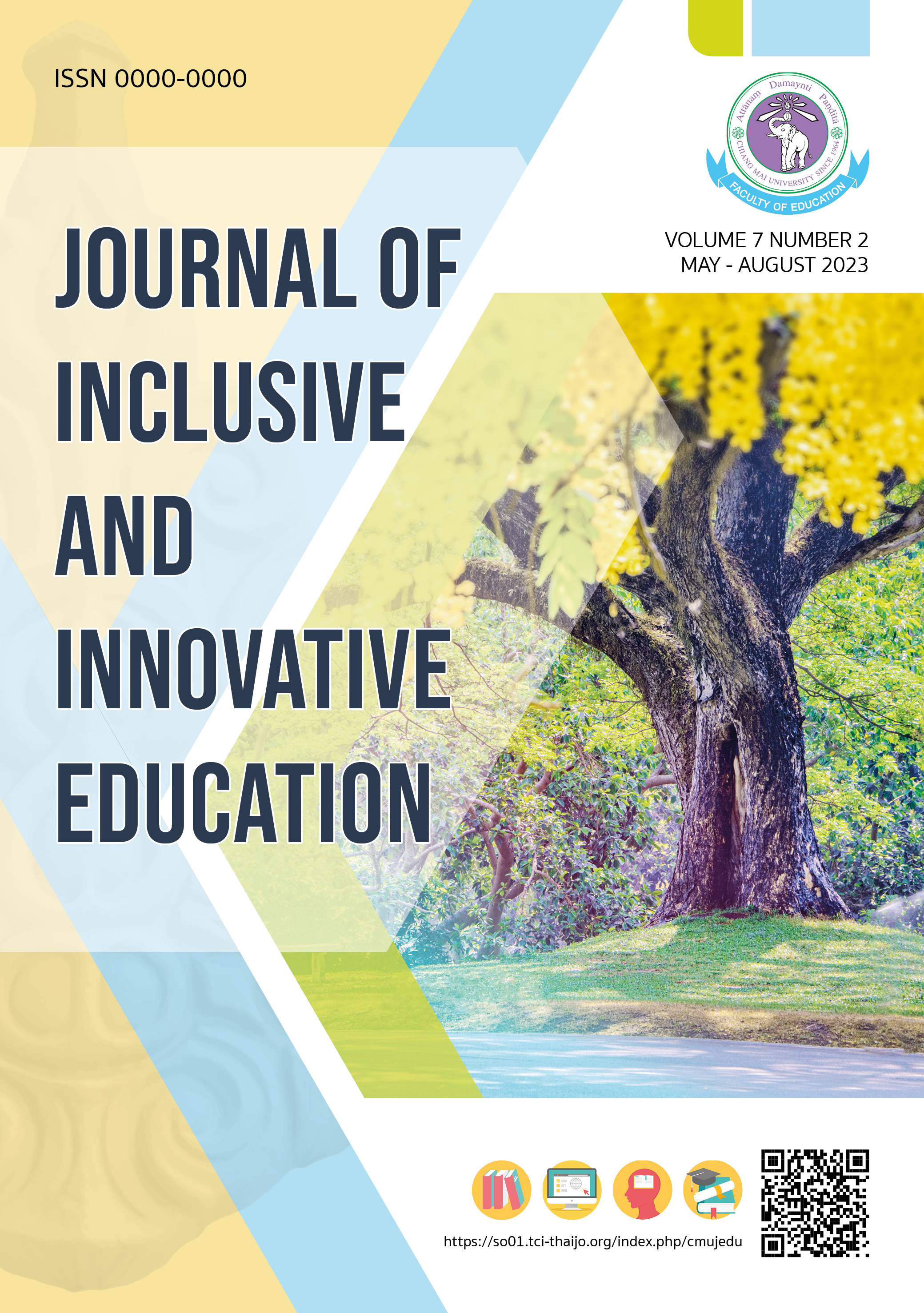การใช้กิจกรรมพหุประสาทสัมผัสเพื่อลดพฤติกรรมซ้ำของนักเรียนออทิซึมสเปคตรัมระดับรุนแรง
Main Article Content
บทคัดย่อ
การวิจัยมีวัตถุประสงค์เพื่อ 1) ลดพฤติกรรมซ้ำของนักเรียนออทิซึมสเปคตรัมระดับรุนแรงด้วยกิจกรรมพหุประสาทสัมผัส 2) วิเคราะห์ความสามารถการใช้แขนและมือของนักเรียนออทิซึมสเปคตรัมระดับรุนแรง การวิจัยเป็นแบบกรณีศึกษา คัดเลือกแบบเจาะจง 1 คน เพศชาย อายุ 10 ปี ได้รับการวินิจฉัยเป็นบุคคลออทิซึมสเปคตรัมระดับรุนแรงร่วมกับ ภาวะบกพร่องการบูรณาการประสาทรับความรู้สึก เรียนชั้นประถมศึกษา โรงเรียนเฉพาะความพิการ รูปแบบงานวิจัยเป็นแบบ Mixed Method เครื่องมือที่ใช้วิจัย 1) แบบสังเกตความถี่พฤติกรรมซ้ำ ในนักเรียนออทิซึมสเปคตรัมระดับรุนแรง (แบบช่วงเวลา) 2) แผนการสอนเฉพาะบุคคล 4 แผน ได้แก่ กิจกรรมลูกแซกพหุประสาทสัมผัส กิจกรรมรดน้ำต้นไม้ กิจกรรมตักซุปพยัญชนะ และกิจกรรมกล่องมหัศจรรย์ 3) แบบสังเกตรายการพฤติกรรมการใช้แขนและมือ ในมิติของความสัมพันธ์ระหว่างการมองและการใช้มือ การเอื้อม การกำ การนำที่มั่นคง และไม่หลีกหนี การควบคุมการทรงตัว การใช้มือทั้งสองเข้ากลางลำตัว การสับเปลี่ยนอุปกรณ์จากมือหนึ่งไปอีกมือหนึ่ง และการปล่อยวัตถุอย่างมีเป้าหมาย 4) แบบประเมิน สิ่งเสริมแรง ดำเนินการวิจัย สัปดาห์ละ 4 กิจกรรม 8 สัปดาห์ รวม 32 ครั้ง วิเคราะห์ข้อมูลด้วยร้อยละ ค่าเฉลี่ย ส่วนเบี่ยงเบนมาตรฐาน และพรรณนา ผลการวิจัยพบว่า ความถี่พฤติกรรมซ้ำก่อนการใช้กิจกรรมพหุประสาทสัมผัส ค่าเฉลี่ย 35.8 ครั้ง/ช่วงเวลา (20 นาที) ส่วนเบี่ยงเบนมาตรฐาน 6.5 และหลังการใช้กิจกรรมพหุประสาทสัมผัส มีความถี่ ค่าเฉลี่ย 8.3 ครั้ง/ช่วงเวลา (20 นาที) ส่วนเบี่ยงเบนมาตรฐาน 3.2 และความสามารถการใช้แขนและมือระหว่างทำกิจกรรมพหุประสาทสัมผัส ดีขึ้นอย่างเห็นได้ชัดในสัปดาห์ที่ 4 เป็นต้นไป
Article Details

อนุญาตภายใต้เงื่อนไข Creative Commons Attribution-NonCommercial-NoDerivatives 4.0 International License.
หากผู้เสนอบทความมีความจำเป็นเร่งด่วนในการตีพิมพ์โปรดส่งลงตีพิมพ์ในวารสารฉบับอื่นแทน โดยกองบรรณาธิการจะไม่รับบทความหากผู้เสนอบทความไม่ปฏิบัติตามเงื่อนไขและขั้นตอนที่กำหนดอย่างเคร่งครัด ข้อมูลของเนื้อหาในบทความถือเป็นลิขสิทธิ์ของ Journal of Inclusive and Innovative Education คณะศึกษาศาสตร์ มหาวิทยาลัยเชียงใหม่
เอกสารอ้างอิง
American Psychiatric Association, Neurodevelopmental Disorders. In: American Psychiatric Association.
(2013). Diagnostic and statistical manual of mental disorders (DSM-5) a (5th ed.). Washington DC: American Psychiatric Publishing.
Arayawinyu, P. (1988). Children disabilities. Bangkok: PA Publishing.
Betty, P., & Carolyn, M. S. (2005). Self-regulation: What is it? and what does sensory processing have to do
with it?. Retrieved from https://www.southpaw.com/self-regulation-what-is-it-and-what-does-sensory-processing-have-to-do-with-it.
Bonadonna, P. (1981). Effects of a Vestibular Stimulation Program on Stereotypic Rocking
Behavior. American Journal of Occupational Therapy, 35, 775–781.
Brandenburg, L. A. (2012). The effects of multi-sensory environments on the stereotypic behaviors of children with autism. Retrieved from https://eric.ed.gov/?id=ED556802.
Bundy, A.C.& Murray, E.A. (2002). Sensory Integration: Theory and Practice. Philadelphia: F.A. Davis
Company.
Chongaonoy, N., Jarutwanitpong, J., Jaisawang, P., Khokeaw, J., Padthulee, D. (2021). A comparison
of motor skills in children with autism spectrum disorder and typically developing children.
Journal of Mental Health of Thailand, 29(3), 229-238. [in Thai]
Chuanongwang, S. (2011). Using sensory motor activities to reduce fingers flicking in child with autism.
Chiang Mai: Faculty of Education, CMU.
Kesarak, W. (2002). Childhood Disintegrative Disorders. Journal of Occupational Therapist Association of Thailand, 6(2), 12-17. [in Thai]
Kosuwan, K. & Viriyangkura, Y. (2021). Autism Spectrum Disorders. Bangkok: Nationbooks. [in Thai]
Kranowit, C. S. (1998). The Out of Sync Child: Recognizing and Coping with Sensory Integrative Dysfunction. New York: Skylight Press.
Lane, S. J., Miller, L. J., & Hant, B. E. (2000). Toward a consensus in terminology in sensory integration theory and practice: part 2: Sensory integration patterns of function and dysfunction. Sensory Integration Special Interest Section Quarterly, 23, 1–3.
Ministry of Education. (2009). Annoucement of Ministry of Education about Type of Learning disability
(June, 8) Rajakijja-Nubegsa126(Special 80). Bangkok: Ministry of Education. [in Thai]
Rivera, M. O., Koorland, M.A., & Fueyo, V. (2002). Pupil-made pictorial prompts and fading for teaching sight words to a student with learning disabilities. Education & Treatment of children, 25(2), 197-208.
Sritana, K., Kaewtatip, A. & Siwor, A. (2019). The Development of Pathways Based on Sensory Integration to Decreasing the Individual Stimulation of Autism Spectrum Disorder (Rett Syndrome
Children) Organized by Clinic for Supportive Physical Development of Children with Special Needs, Chiangrai Rajabhat University. Journal of Phetchaburi Rajabhat University, 9(1), 195-203. [in Thai]
Wittayakorn, S., Chinchai, S.,Sripetcharawut, S. (2012). Sensory integration frame of reference : theory
and clinical practice in occupational therapy. Chiang Mai: Faculty of Associated Medical
Sciences, CMU. [in Thai]


